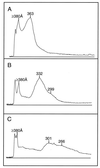Lamellar lipoproteins uniquely contribute to hyperlipidemia in mice doubly deficient in apolipoprotein E and hepatic lipase
- PMID: 9861024
- PMCID: PMC28098
- DOI: 10.1073/pnas.95.26.15647
Lamellar lipoproteins uniquely contribute to hyperlipidemia in mice doubly deficient in apolipoprotein E and hepatic lipase
Abstract
Remnants of triglyceride-rich lipoproteins containing apolipoprotein (apo) B-48 accumulate in apo E-deficient mice, causing pronounced hypercholesterolemia. Mice doubly deficient in apo E and hepatic lipase have more pronounced hypercholesterolemia, even though remnants do not accumulate appreciably in mice deficient in hepatic lipase alone. Here we show that the doubly deficient mice manifest a unique lamellar hyperlipoproteinemia, characterized by vesicular particles 600 A-1,300 A in diameter. As seen by negative-staining electron microscopy, these lipoproteins also contain an electron-lucent region adjacent to the vesicle wall, similar to the core of typical lipoproteins. Correlative chemical analysis indicates that the vesicle wall is composed of a 1:1 molar mixture of cholesterol and phospholipids, whereas the electron-lucent region appears to be composed of cholesteryl esters (about 12% of the particle mass). Like the spherical lipoproteins of doubly deficient mice, the vesicular particles contain apo B-48, but they are particularly rich in apo A-IV. We propose that cholesteryl esters are removed from spherical lipoproteins of these mice by scavenger receptor B1, leaving behind polar lipid-rich particles that fuse to form vesicular lipoproteins. Hepatic lipase may prevent such vesicular lipoproteins from accumulating in apo E-deficient mice by hydrolyzing phosphatidyl choline as scavenger receptor B1 removes the cholesteryl esters and by gradual endocytosis of lipoproteins bound to hepatic lipase on the surface of hepatocytes.
Figures




Similar articles
-
Metabolism of lipoproteins containing apolipoprotein B in hepatic lipase-deficient mice.J Lipid Res. 1998 Aug;39(8):1661-8. J Lipid Res. 1998. PMID: 9717727
-
Effect of heparin-induced lipolysis on the distribution of apolipoprotein e among lipoprotein subclasses. Studies with patients deficient in hepatic triglyceride lipase and lipoprotein lipase.J Clin Invest. 1985 Feb;75(2):710-21. doi: 10.1172/JCI111751. J Clin Invest. 1985. PMID: 3973025 Free PMC article.
-
Impact of combined deficiency of hepatic lipase and endothelial lipase on the metabolism of both high-density lipoproteins and apolipoprotein B-containing lipoproteins.Circ Res. 2010 Aug 6;107(3):357-64. doi: 10.1161/CIRCRESAHA.110.219188. Epub 2010 Jun 17. Circ Res. 2010. PMID: 20558822 Free PMC article.
-
Acute dyslipoproteinemia induced by interleukin-2: lecithin:cholesteryl acyltransferase, lipoprotein lipase, and hepatic lipase deficiencies.J Clin Endocrinol Metab. 1997 May;82(5):1572-81. doi: 10.1210/jcem.82.5.3937. J Clin Endocrinol Metab. 1997. PMID: 9141552
-
Gene therapy for atherosclerosis.Int J Clin Lab Res. 1997;27(1):35-43. doi: 10.1007/BF02827240. Int J Clin Lab Res. 1997. PMID: 9144025 Review.
Cited by
-
Targeted mutation of plasma phospholipid transfer protein gene markedly reduces high-density lipoprotein levels.J Clin Invest. 1999 Mar;103(6):907-14. doi: 10.1172/JCI5578. J Clin Invest. 1999. PMID: 10079112 Free PMC article.
-
Apolipoprotein B48, the Structural Component of Chylomicrons, Is Sufficient to Antagonize Staphylococcus aureus Quorum-Sensing.PLoS One. 2015 May 5;10(5):e0125027. doi: 10.1371/journal.pone.0125027. eCollection 2015. PLoS One. 2015. PMID: 25942561 Free PMC article.
-
Probucol prevents early coronary heart disease and death in the high-density lipoprotein receptor SR-BI/apolipoprotein E double knockout mouse.Proc Natl Acad Sci U S A. 2003 Jun 10;100(12):7283-8. doi: 10.1073/pnas.1237725100. Epub 2003 May 27. Proc Natl Acad Sci U S A. 2003. PMID: 12771386 Free PMC article.
-
Speciated human high-density lipoprotein protein proximity profiles.Biochemistry. 2010 Dec 21;49(50):10656-65. doi: 10.1021/bi1015452. Epub 2010 Nov 23. Biochemistry. 2010. PMID: 21073165 Free PMC article.
-
Gall Wasp Transcriptomes Unravel Potential Effectors Involved in Molecular Dialogues With Oak and Rose.Front Physiol. 2019 Jul 24;10:926. doi: 10.3389/fphys.2019.00926. eCollection 2019. Front Physiol. 2019. PMID: 31396099 Free PMC article.
References
-
- Havel R J. Curr Opin Lipidol. 1995;6:312–316. - PubMed
-
- Zhang S H, Reddick R L, Piedrahita J A, Maeda N. Science. 1992;258:468–471. - PubMed
-
- Plump A, Smith J, Hayek T, Aalto-Setala K, Walsh A, Verstuyft J, Rubin E, Breslow J. Cell. 1992;71:343–353. - PubMed
-
- Ghiselli G, Schaefer E J, Gascon P, Brewer H B., Jr Science. 1981;214:1239–1241. - PubMed
-
- Qiu S, Bergeron N, Kotite L, Krauss R M, Bensadoun A, Havel R J. J Lipid Res. 1998;39:1661–1668. - PubMed
Publication types
MeSH terms
Substances
Grants and funding
LinkOut - more resources
Full Text Sources
Medical
Molecular Biology Databases
Research Materials

